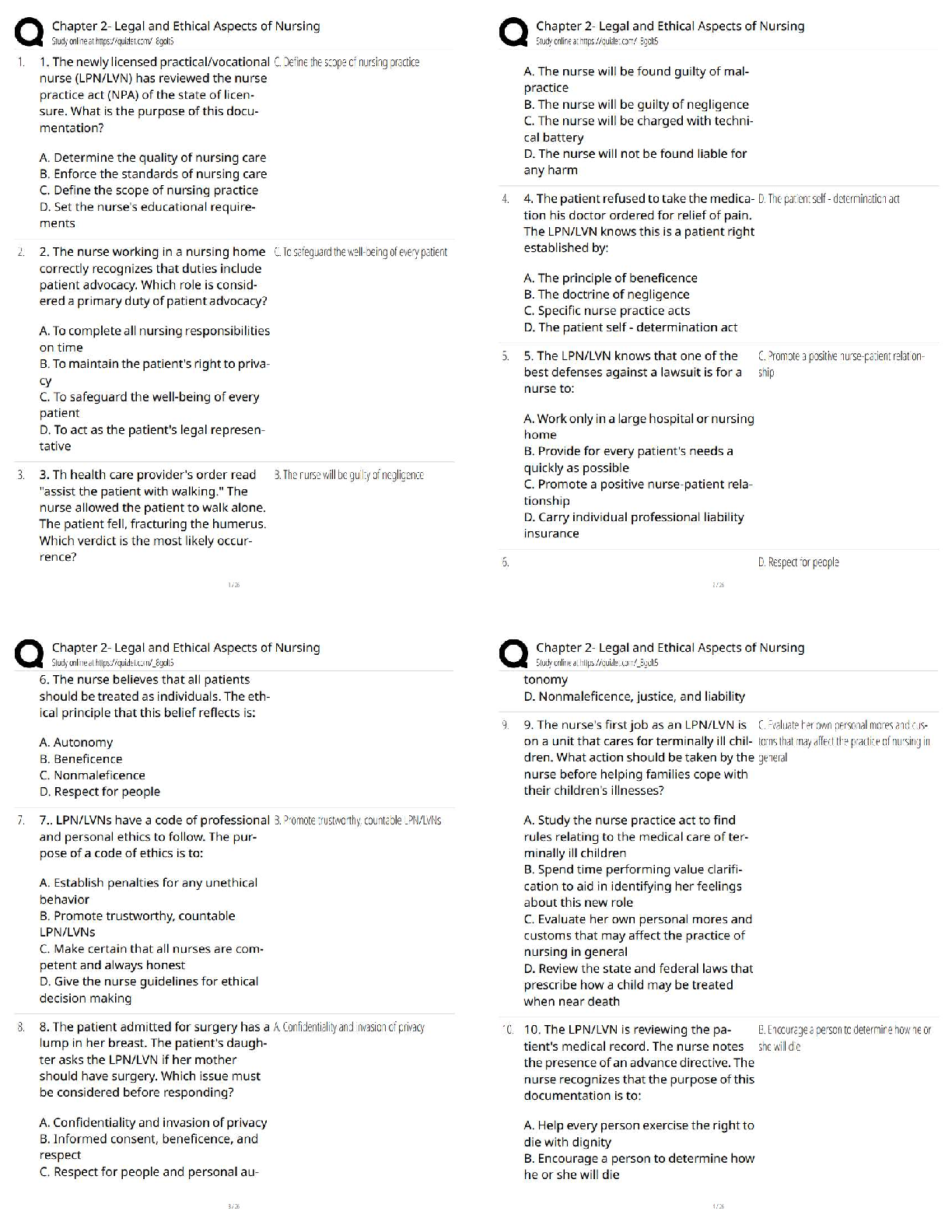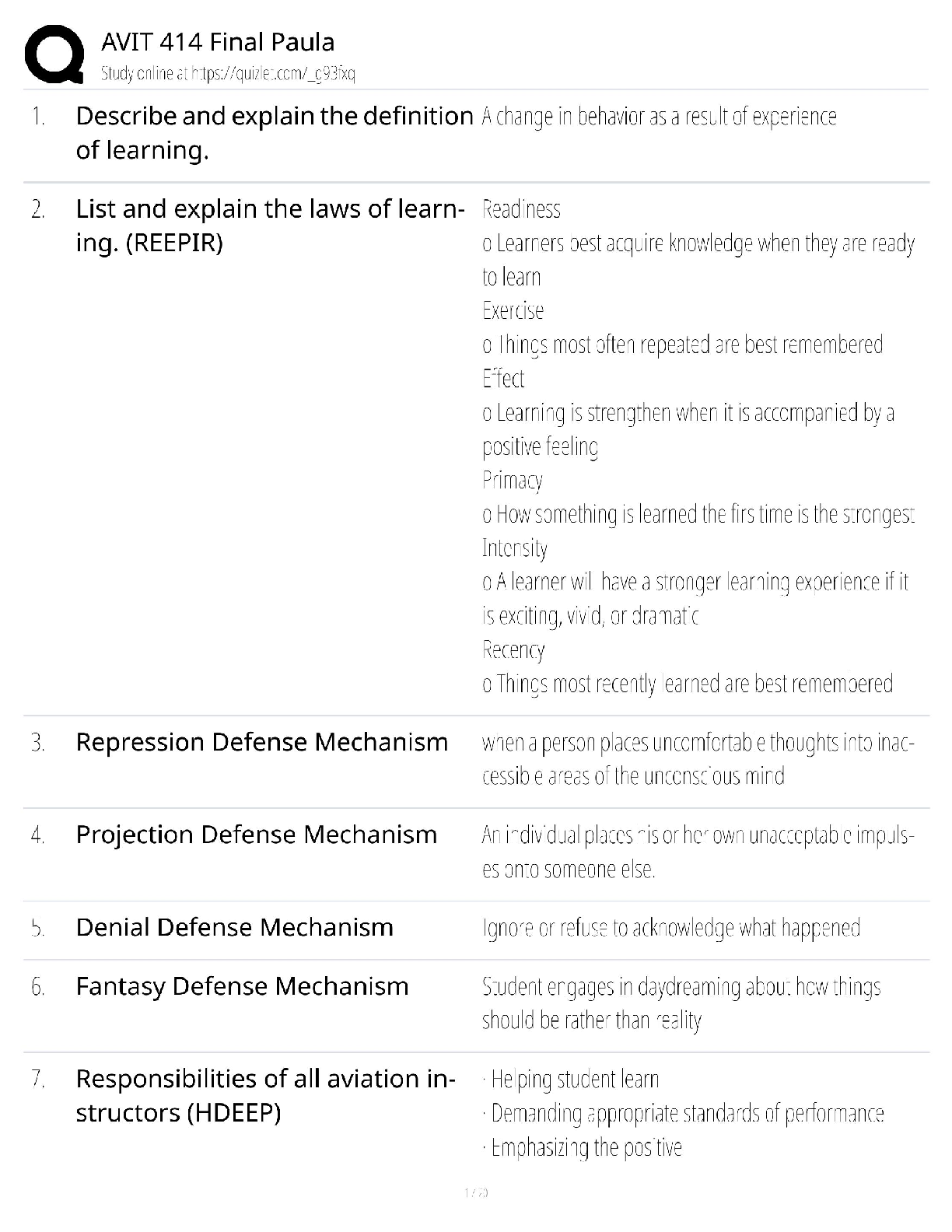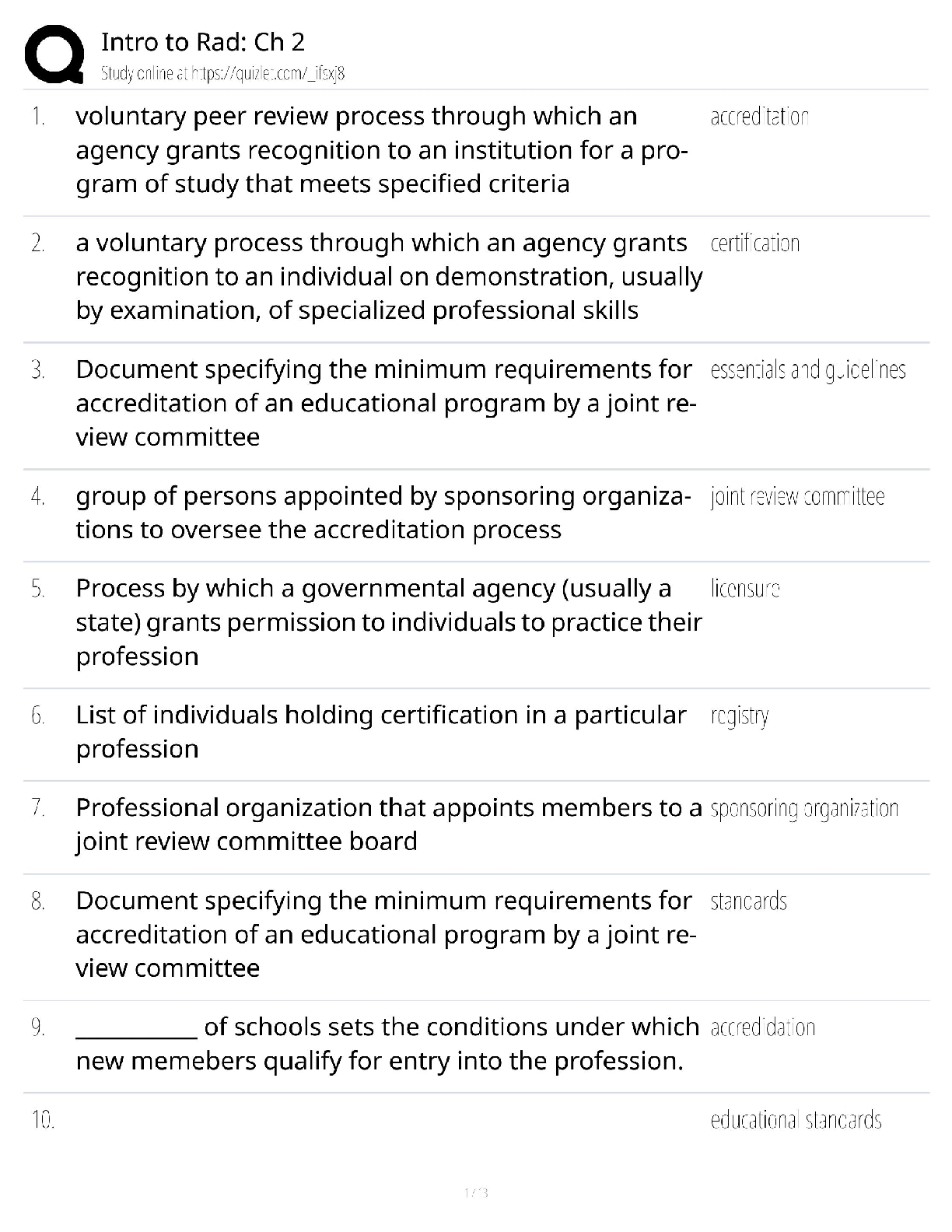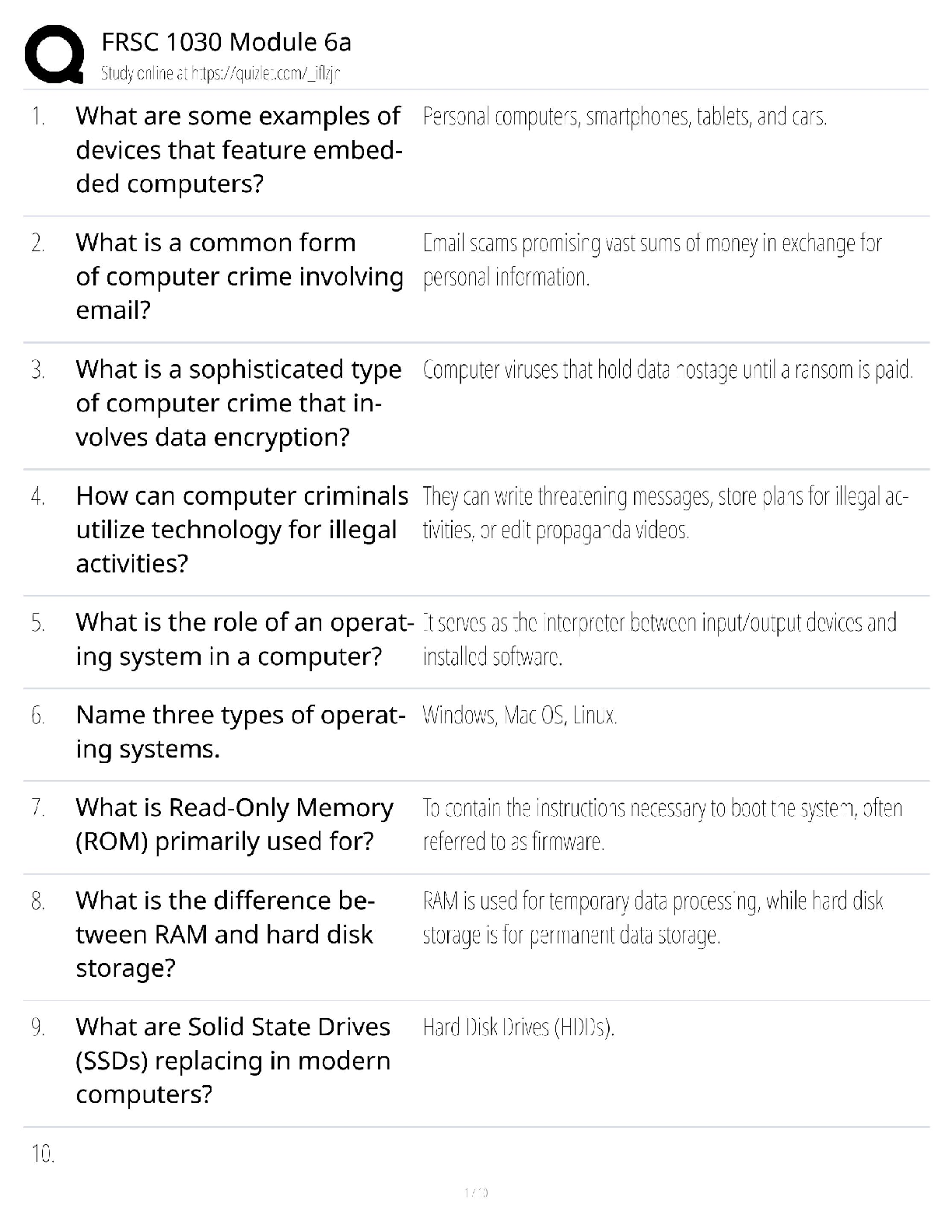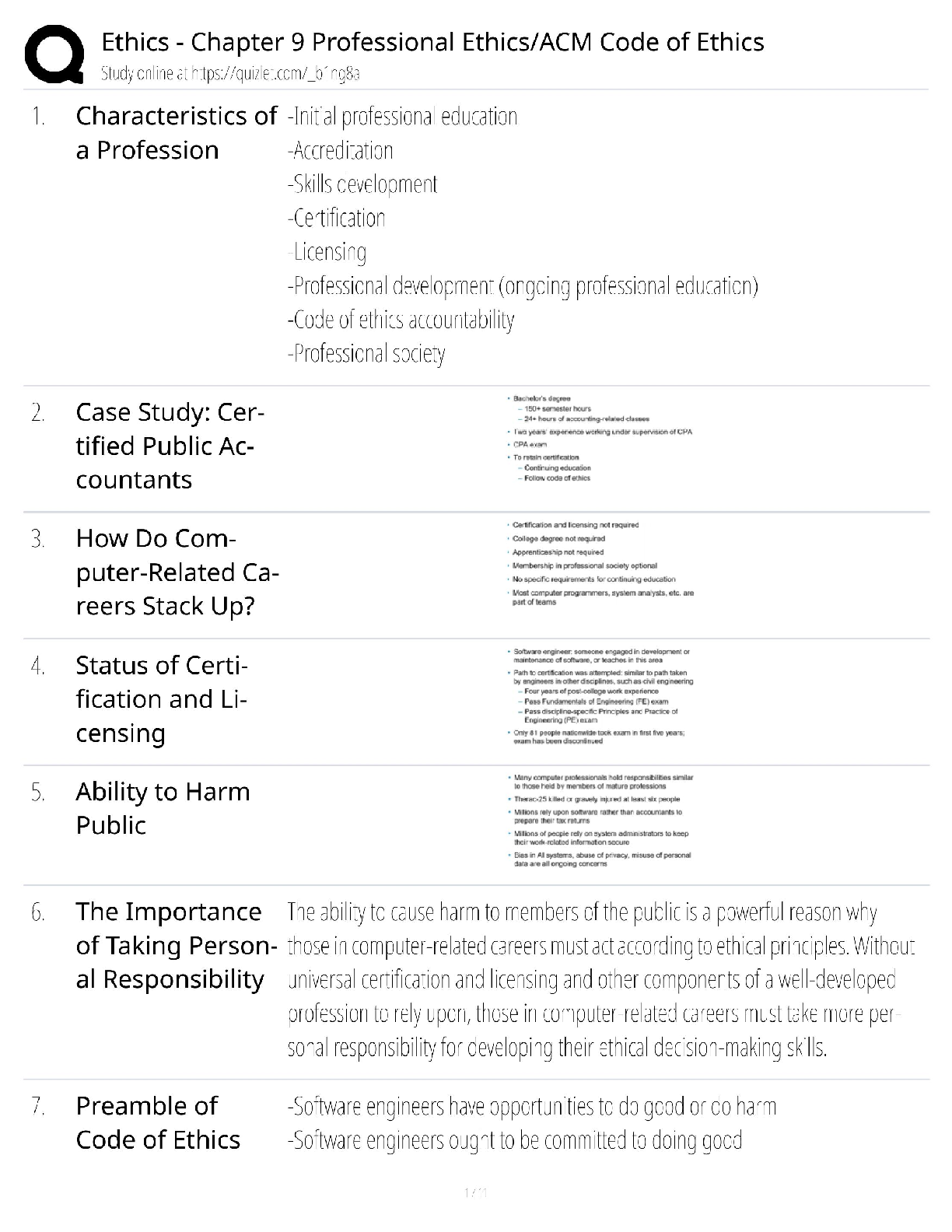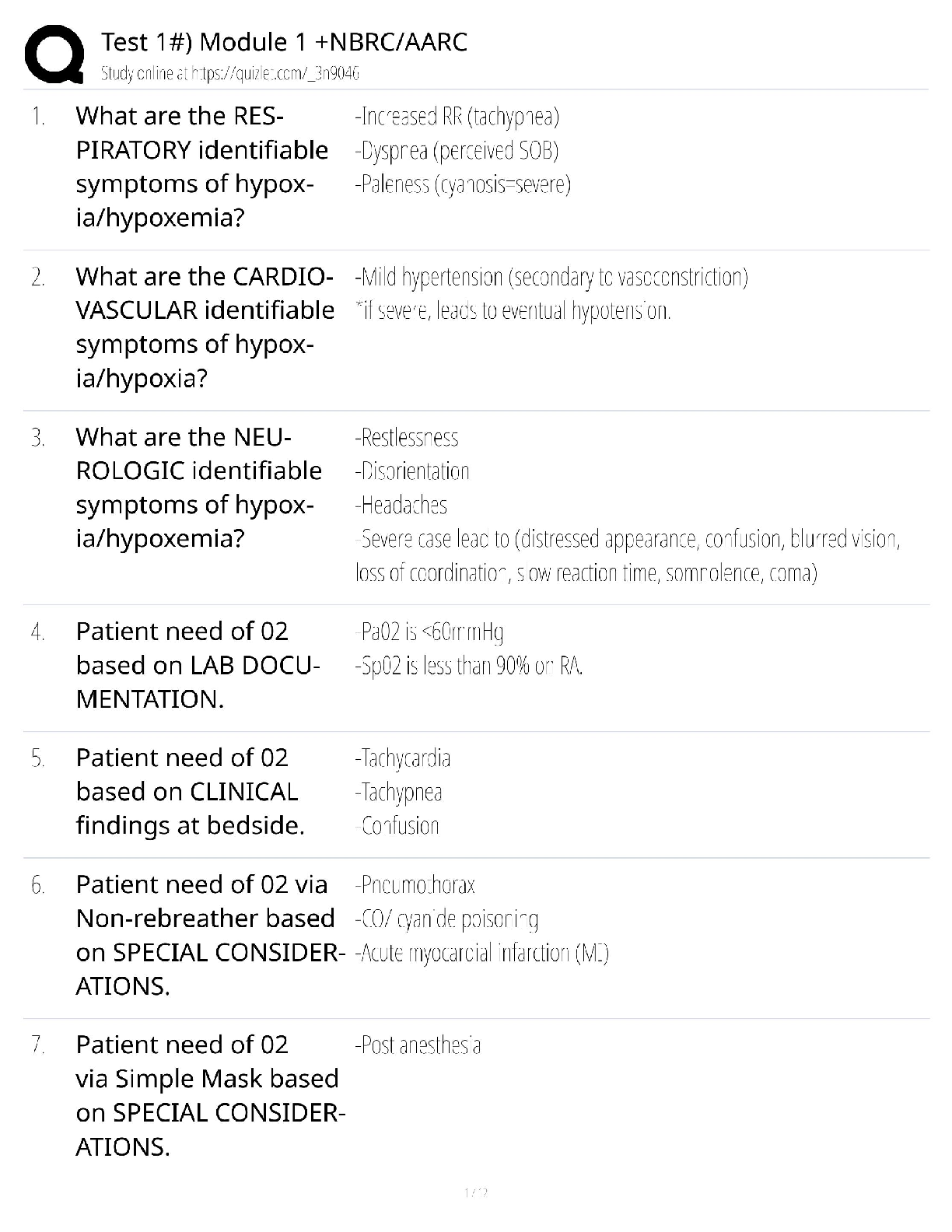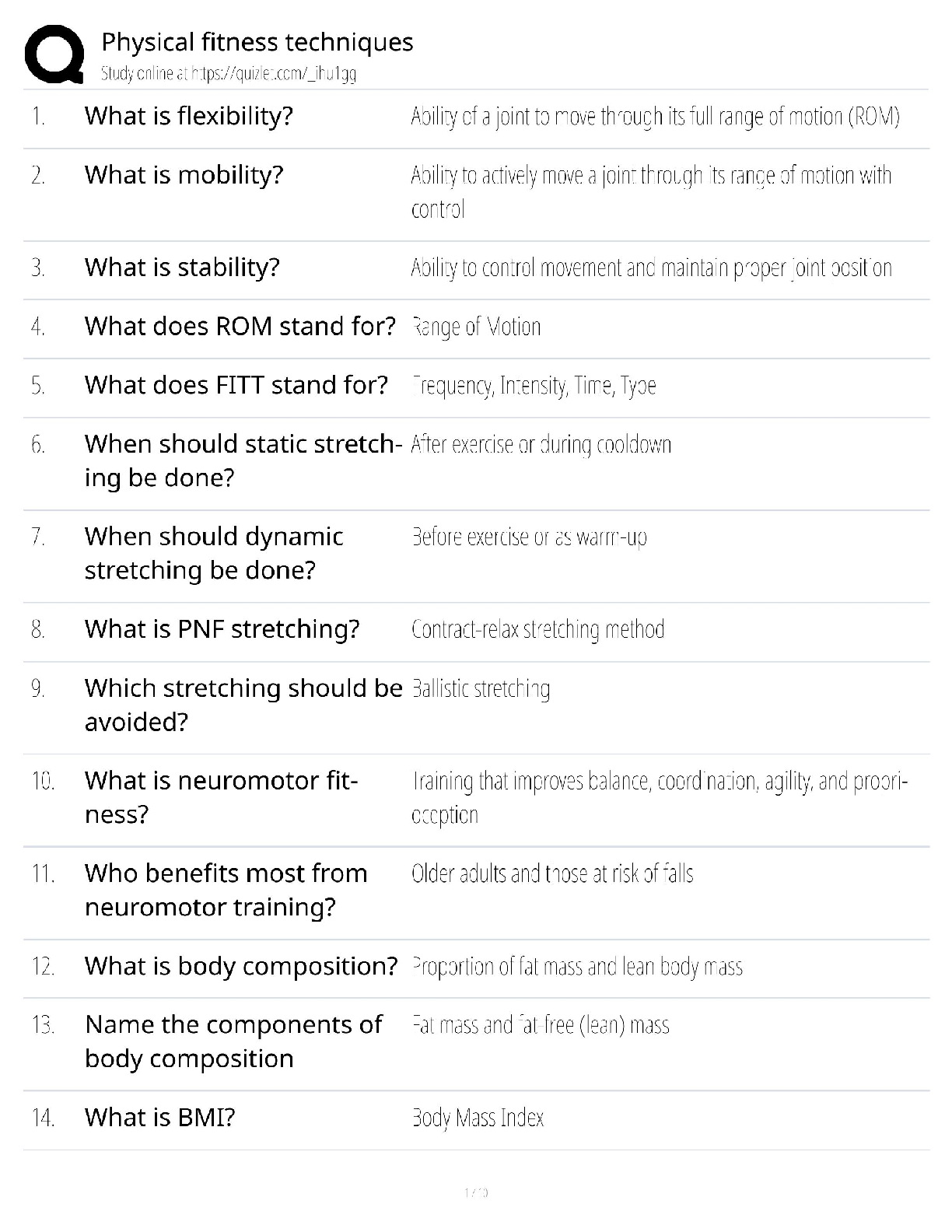Computer Networking > QUESTIONS & ANSWERS > NETW 563/: NETW563 FINAL EXAM MULTIPLE CHOICE PRACTICE EXAM QUESTIONS AND ANSWERS (All)
NETW 563/: NETW563 FINAL EXAM MULTIPLE CHOICE PRACTICE EXAM QUESTIONS AND ANSWERS
Document Content and Description Below
NETW 563/: NETW563 FINAL EXAM MULTIPLE CHOICE PRACTICE EXAM QUESTIONS AND ANSWERS (TCO A) An access point has a(n) _____ interface that allows it to connect to a wired network. (Points : 5) ... RJ-45 SDDIO CF RJ-111 Question 2.2. (TCO A) How often an event occurs can create different ______. (Points : 5) modulations frequencies cycles gigapops (GPS) Question 3.3. (TCO B) What is not an advantage of LEO satellites over GEO satellites? (Points : 5) Require fewer hand-offs Reduced propagation delay Coverage can be better localized Better conservation of spectrum Question 4.4. (TCO C) _____ is a group of wireless devices that is served by a single access point (AP). (Points : 5) Basic Service Set Ad hoc mode Extended Service Set Independent Service Set Question 5.5. (TCO D) Each of the following are locations in which businesses install wireless networks for increased employee productivity except (Points : 5) lobbies. lunchrooms. common areas. Remote parking lots. Question 6.6. (TCO E) Guarding the availability of information is achieved by (Points : 5) access control. closed system authentication. wireless protection environment (WPE). frame count check (FCC). Question 7.7. (TCO F) What is the equivalent of one Erlang? (Points : 5) 60 call seconds 36 centum call seconds 3600 centum call seconds 1 minute Question 8.8. (TCO G) _____ provides users the freedom to roam beyond their home subnets while still maintaining their home IP addresses. (Points : 5) Mobile IP TCP/IP IPX/SPX Routing Initiation Protocol (RIP) ESSAY QUESTIONS (TCO A) What is polarization, and why is it important to WLANs? (Points : 30) Polarization is an expression of the manner by which the lines of electric flux are oriented in an electromagnetic field. It can either rotate with each wave cycle or it can have the same specific orientation at all times. It is important in wireless LANs in that a wireless antenna’s physical orientation corresponds to the radio waves that the antenna transmits and receives. Vertically polarized waves are received and emitted by vertical antennas whereas horizontally polarized waves are received and emitted by horizontal antennas. In this regard, the communication or wireless connection is improved when the receiving and transmitting antennas have the same polarization. Reference http://whatis.techtarget.com/definition/polarization-wave-polarization (TCO B) In cellular systems, what are the two types of channels used between the mobile unit and the base station? What are their functions? (Points : 30) The two types of channels are the control and traffic channels. Control channels are used for exchanging information regarding the initiation and maintenance of calls and for establishing a relationship between the base station and the mobile unit. It is used for the transfer of diagnostic and control information between a central cellular switch and the mobile unit through a cell-site. On the other hand, the traffic channel is the actual voice channel where mobile subscribers communicate with each other. In particular, base channels receive on the reverse voice and reverse control channels and transmits on the forward voice and forward control channels. In the same manner, mobile subscribers receive on the forward voice and forward control channel and transmit on the reverse voice and reverse control channels. Reference: https://books.google.com/books?id=cQJJzA8CCUUC HYPERLINK "https://books.google.com/books?id=cQJJzA8CCUUC&pg=PA307&lpg=PA307&dq=two+types+of+channels+between+the+mobile+unit+and+the+base+station&source=bl&ots=MnP6Nxlv38&sig=OryU_bFVRfXW7KyDkIeXQ2BGrNE&hl=en&sa=X&ved=0CCwQ6AEwBGoVChMImtmAvfPYxwIVCY-OCh2X2Q8i"& HYPERLINK "https://books.google.com/books?id=cQJJzA8CCUUC&pg=PA307&lpg=PA307&dq=two+types+of+channels+between+the+mobile+unit+and+the+base+station&source=bl&ots=MnP6Nxlv38&sig=OryU_bFVRfXW7KyDkIeXQ2BGrNE&hl=en&sa=X&ved=0CCwQ6AEwBGoVChMImtmAvfPYxwIVCY-OCh2X2Q8i"pg=PA307 HYPERLINK "https://books.google.com/books?id=cQJJzA8CCUUC&pg=PA307&lpg=PA307&dq=two+types+of+channels+between+the+mobile+unit+and+the+base+station&source=bl&ots=MnP6Nxlv38&sig=OryU_bFVRfXW7KyDkIeXQ2BGrNE&hl=en&sa=X&ved=0CCwQ6AEwBGoVChMImtmAvfPYxwIVCY-OCh2X2Q8i"& HYPERLINK "https://books.google.com/books?id=cQJJzA8CCUUC&pg=PA307&lpg=PA307&dq=two+types+of+channels+between+the+mobile+unit+and+the+base+station&source=bl&ots=MnP6Nxlv38&sig=OryU_bFVRfXW7KyDkIeXQ2BGrNE&hl=en&sa=X&ved=0CCwQ6AEwBGoVChMImtmAvfPYxwIVCY-OCh2X2Q8i"lpg=PA307 HYPERLINK "https://books.google.com/books?id=cQJJzA8CCUUC&pg=PA307&lpg=PA307&dq=two+types+of+channels+between+the+mobile+unit+and+the+base+station&source=bl&ots=MnP6Nxlv38&sig=OryU_bFVRfXW7KyDkIeXQ2BGrNE&hl=en&sa=X&ved=0CCwQ6AEwBGoVChMImtmAvfPYxwIVCY-OCh2X2Q8i"& HYPERLINK "https://books.google.com/books?id=cQJJzA8CCUUC&pg=PA307&lpg=PA307&dq=two+types+of+channels+between+the+mobile+unit+and+the+base+station&source=bl&ots=MnP6Nxlv38&sig=OryU_bFVRfXW7KyDkIeXQ2BGrNE&hl=en&sa=X&ved=0CCwQ6AEwBGoVChMImtmAvfPYxwIVCY-OCh2X2Q8i"dq=two+types+of+channels+between+the+mobile+unit+and+the+base+station HYPERLINK "https://books.google.com/books?id=cQJJzA8CCUUC&pg=PA307&lpg=PA307&dq=two+types+of+channels+between+the+mobile+unit+and+the+base+station&source=bl&ots=MnP6Nxlv38&sig=OryU_bFVRfXW7KyDkIeXQ2BGrNE&hl=en&sa=X&ved=0CCwQ6AEwBGoVChMImtmAvfPYxwIVCY-OCh2X2Q8i"& HYPERLINK "https://books.google.com/books?id=cQJJzA8CCUUC&pg=PA307&lpg=PA307&dq=two+types+of+channels+between+the+mobile+unit+and+the+base+station&source=bl&ots=MnP6Nxlv38&sig=OryU_bFVRfXW7KyDkIeXQ2BGrNE&hl=en&sa=X&ved=0CCwQ6AEwBGoVChMImtmAvfPYxwIVCY-OCh2X2Q8i"source=bl HYPERLINK "https://books.google.com/books?id=cQJJzA8CCUUC&pg=PA307&lpg=PA307&dq=two+types+of+channels+between+the+mobile+unit+and+the+base+station&source=bl&ots=MnP6Nxlv38&sig=OryU_bFVRfXW7KyDkIeXQ2BGrNE&hl=en&sa=X&ved=0CCwQ6AEwBGoVChMImtmAvfPYxwIVCY-OCh2X2Q8i"& HYPERLINK "https://books.google.com/books?id=cQJJzA8CCUUC&pg=PA307&lpg=PA307&dq=two+types+of+channels+between+the+mobile+unit+and+the+base+station&source=bl&ots=MnP6Nxlv38&sig=OryU_bFVRfXW7KyDkIeXQ2BGrNE&hl=en&sa=X&ved=0CCwQ6AEwBGoVChMImtmAvfPYxwIVCY-OCh2X2Q8i"ots=MnP6Nxlv38 HYPERLINK "https://books.google.com/books?id=cQJJzA8CCUUC&pg=PA307&lpg=PA307&dq=two+types+of+channels+between+the+mobile+unit+and+the+base+station&source=bl&ots=MnP6Nxlv38&sig=OryU_bFVRfXW7KyDkIeXQ2BGrNE&hl=en&sa=X&ved=0CCwQ6AEwBGoVChMImtmAvfPYxwIVCY-OCh2X2Q8i"& HYPERLINK "https://books.google.com/books?id=cQJJzA8CCUUC&pg=PA307&lpg=PA307&dq=two+types+of+channels+between+the+mobile+unit+and+the+base+station&source=bl&ots=MnP6Nxlv38&sig=OryU_bFVRfXW7KyDkIeXQ2BGrNE&hl=en&sa=X&ved=0CCwQ6AEwBGoVChMImtmAvfPYxwIVCY-OCh2X2Q8i"sig=OryU_bFVRfXW7KyDkIeXQ2BGrNE HYPERLINK "https://books.google.com/books?id=cQJJzA8CCUUC&pg=PA307&lpg=PA307&dq=two+types+of+channels+between+the+mobile+unit+and+the+base+station&source=bl&ots=MnP6Nxlv38&sig=OryU_bFVRfXW7KyDkIeXQ2BGrNE&hl=en&sa=X&ved=0CCwQ6AEwBGoVChMImtmAvfPYxwIVCY-OCh2X2Q8i"& HYPERLINK "https://books.google.com/books?id=cQJJzA8CCUUC&pg=PA307&lpg=PA307&dq=two+types+of+channels+between+the+mobile+unit+and+the+base+station&source=bl&ots=MnP6Nxlv38&sig=OryU_bFVRfXW7KyDkIeXQ2BGrNE&hl=en&sa=X&ved=0CCwQ6AEwBGoVChMImtmAvfPYxwIVCY-OCh2X2Q8i"hl=en HYPERLINK "https://books.google.com/books?id=cQJJzA8CCUUC&pg=PA307&lpg=PA307&dq=two+types+of+channels+between+the+mobile+unit+and+the+base+station&source=bl&ots=MnP6Nxlv38&sig=OryU_bFVRfXW7KyDkIeXQ2BGrNE&hl=en&sa=X&ved=0CCwQ6AEwBGoVChMImtmAvfPYxwIVCY-OCh2X2Q8i"& HYPERLINK "https://books.google.com/books?id=cQJJzA8CCUUC&pg=PA307&lpg=PA307&dq=two+types+of+channels+between+the+mobile+unit+and+the+base+station&source=bl&ots=MnP6Nxlv38&sig=OryU_bFVRfXW7KyDkIeXQ2BGrNE&hl=en&sa=X&ved=0CCwQ6AEwBGoVChMImtmAvfPYxwIVCY-OCh2X2Q8i"sa=X HYPERLINK "https://books.google.com/books?id=cQJJzA8CCUUC&pg=PA307&lpg=PA307&dq=two+types+of+channels+between+the+mobile+unit+and+the+base+station&source=bl&ots=MnP6Nxlv38&sig=OryU_bFVRfXW7KyDkIeXQ2BGrNE&hl=en&sa=X&ved=0CCwQ6AEwBGoVChMImtmAvfPYxwIVCY-OCh2X2Q8i"& HYPERLINK "https://books.google.com/books?id=cQJJzA8CCUUC&pg=PA307&lpg=PA307&dq=two+types+of+channels+between+the+mobile+unit+and+the+base+station&source=bl&ots=MnP6Nxlv38&sig=OryU_bFVRfXW7KyDkIeXQ2BGrNE&hl=en&sa=X&ved=0CCwQ6AEwBGoVChMImtmAvfPYxwIVCY-OCh2X2Q8i"ved=0CCwQ6AEwBGoVChMImtmAvfPYxwIVCY-OCh2X2Q8i#v=onepage HYPERLINK "https://books.google.com/books?id=cQJJzA8CCUUC&pg=PA307&lpg=PA307&dq=two+types+of+channels+between+the+mobile+unit+and+the+base+station&source=bl&ots=MnP6Nxlv38&sig=OryU_bFVRfXW7KyDkIeXQ2BGrNE&hl=en&sa=X&ved=0CCwQ6AEwBGoVChMImtmAvfPYxwIVCY-OCh2X2Q8i"& HYPERLINK "https://books.google.com/books?id=cQJJzA8CCUUC&pg=PA307&lpg=PA307&dq=two+types+of+channels+between+the+mobile+unit+and+the+base+station&source=bl&ots=MnP6Nxlv38&sig=OryU_bFVRfXW7KyDkIeXQ2BGrNE&hl=en&sa=X&ved=0CCwQ6AEwBGoVChMImtmAvfPYxwIVCY-OCh2X2Q8i"q=two%20types%20of%20channels%20between%20the%20mobile%20unit%20and%20the%20base%20station HYPERLINK "https://books.google.com/books?id=cQJJzA8CCUUC&pg=PA307&lpg=PA307&dq=two+types+of+channels+between+the+mobile+unit+and+the+base+station&source=bl&ots=MnP6Nxlv38&sig=OryU_bFVRfXW7KyDkIeXQ2BGrNE&hl=en&sa=X&ved=0CCwQ6AEwBGoVChMImtmAvfPYxwIVCY-OCh2X2Q8i"& HYPERLINK "https://books.google.com/books?id=cQJJzA8CCUUC&pg=PA307&lpg=PA307&dq=two+types+of+channels+between+the+mobile+unit+and+the+base+station&source=bl&ots=MnP6Nxlv38&sig=OryU_bFVRfXW7KyDkIeXQ2BGrNE&hl=en&sa=X&ved=0CCwQ6AEwBGoVChMImtmAvfPYxwIVCY-OCh2X2Q8i"f=false (TCO C) Explain how power management functions on an infrastructure network. (Points : 30) The access point controls power management in an infrastructure network. In this regard, a base station that wants to function in power-save mode must inform the access point of such by setting the power management bits in a frame’s frame control field. After this, the access point can no longer send a packet to the mobile station at any time; rather, it must buffer the packets and send them only to the mobile stations at the times when the mobile station is not in save mode. Reference: https://books.google.com/books?id=utTrj26vay0C HYPERLINK "https://books.google.com/books?id=utTrj26vay0C&pg=PA171&lpg=PA171&dq=how+power+management+functions+on+an+infrastructure+network&source=bl&ots=dZ9E9GZm4y&sig=rrDQtWaQh_KcctrkooGafypxgL4&hl=en&sa=X&ved=0CFYQ6AEwBmoVChMIu4_6gvnYxwIVxo-OCh3tzQxK"& HYPERLINK "https://books.google.com/books?id=utTrj26vay0C&pg=PA171&lpg=PA171&dq=how+power+management+functions+on+an+infrastructure+network&source=bl&ots=dZ9E9GZm4y&sig=rrDQtWaQh_KcctrkooGafypxgL4&hl=en&sa=X&ved=0CFYQ6AEwBmoVChMIu4_6gvnYxwIVxo-OCh3tzQxK"pg=PA171 HYPERLINK "https://books.google.com/books?id=utTrj26vay0C&pg=PA171&lpg=PA171&dq=how+power+management+functions+on+an+infrastructure+network&source=bl&ots=dZ9E9GZm4y&sig=rrDQtWaQh_KcctrkooGafypxgL4&hl=en&sa=X&ved=0CFYQ6AEwBmoVChMIu4_6gvnYxwIVxo-OCh3tzQxK"& HYPERLINK "https://books.google.com/books?id=utTrj26vay0C&pg=PA171&lpg=PA171&dq=how+power+management+functions+on+an+infrastructure+network&source=bl&ots=dZ9E9GZm4y&sig=rrDQtWaQh_KcctrkooGafypxgL4&hl=en&sa=X&ved=0CFYQ6AEwBmoVChMIu4_6gvnYxwIVxo-OCh3tzQxK"lpg=PA171 HYPERLINK "https://books.google.com/books?id=utTrj26vay0C&pg=PA171&lpg=PA171&dq=how+power+management+functions+on+an+infrastructure+network&source=bl&ots=dZ9E9GZm4y&sig=rrDQtWaQh_KcctrkooGafypxgL4&hl=en&sa=X&ved=0CFYQ6AEwBmoVChMIu4_6gvnYxwIVxo-OCh3tzQxK"& HYPERLINK "https://books.google.com/books?id=utTrj26vay0C&pg=PA171&lpg=PA171&dq=how+power+management+functions+on+an+infrastructure+network&source=bl&ots=dZ9E9GZm4y&sig=rrDQtWaQh_KcctrkooGafypxgL4&hl=en&sa=X&ved=0CFYQ6AEwBmoVChMIu4_6gvnYxwIVxo-OCh3tzQxK"dq=how+power+management+functions+on+an+infrastructure+network HYPERLINK "https://books.google.com/books?id=utTrj26vay0C&pg=PA171&lpg=PA171&dq=how+power+management+functions+on+an+infrastructure+network&source=bl&ots=dZ9E9GZm4y&sig=rrDQtWaQh_KcctrkooGafypxgL4&hl=en&sa=X&ved=0CFYQ6AEwBmoVChMIu4_6gvnYxwIVxo-OCh3tzQxK"& HYPERLINK "https://books.google.com/books?id=utTrj26vay0C&pg=PA171&lpg=PA171&dq=how+power+management+functions+on+an+infrastructure+network&source=bl&ots=dZ9E9GZm4y&sig=rrDQtWaQh_KcctrkooGafypxgL4&hl=en&sa=X&ved=0CFYQ6AEwBmoVChMIu4_6gvnYxwIVxo-OCh3tzQxK"source=bl HYPERLINK "https://books.google.com/books?id=utTrj26vay0C&pg=PA171&lpg=PA171&dq=how+power+management+functions+on+an+infrastructure+network&source=bl&ots=dZ9E9GZm4y&sig=rrDQtWaQh_KcctrkooGafypxgL4&hl=en&sa=X&ved=0CFYQ6AEwBmoVChMIu4_6gvnYxwIVxo-OCh3tzQxK"& HYPERLINK "https://books.google.com/books?id=utTrj26vay0C&pg=PA171&lpg=PA171&dq=how+power+management+functions+on+an+infrastructure+network&source=bl&ots=dZ9E9GZm4y&sig=rrDQtWaQh_KcctrkooGafypxgL4&hl=en&sa=X&ved=0CFYQ6AEwBmoVChMIu4_6gvnYxwIVxo-OCh3tzQxK"ots=dZ9E9GZm4y HYPERLINK "https://books.google.com/books?id=utTrj26vay0C&pg=PA171&lpg=PA171&dq=how+power+management+functions+on+an+infrastructure+network&source=bl&ots=dZ9E9GZm4y&sig=rrDQtWaQh_KcctrkooGafypxgL4&hl=en&sa=X&ved=0CFYQ6AEwBmoVChMIu4_6gvnYxwIVxo-OCh3tzQxK"& HYPERLINK "https://books.google.com/books?id=utTrj26vay0C&pg=PA171&lpg=PA171&dq=how+power+management+functions+on+an+infrastructure+network&source=bl&ots=dZ9E9GZm4y&sig=rrDQtWaQh_KcctrkooGafypxgL4&hl=en&sa=X&ved=0CFYQ6AEwBmoVChMIu4_6gvnYxwIVxo-OCh3tzQxK"sig=rrDQtWaQh_KcctrkooGafypxgL4 HYPERLINK "https://books.google.com/books?id=utTrj26vay0C&pg=PA171&lpg=PA171&dq=how+power+management+functions+on+an+infrastructure+network&source=bl&ots=dZ9E9GZm4y&sig=rrDQtWaQh_KcctrkooGafypxgL4&hl=en&sa=X&ved=0CFYQ6AEwBmoVChMIu4_6gvnYxwIVxo-OCh3tzQxK"& HYPERLINK "https://books.google.com/books?id=utTrj26vay0C&pg=PA171&lpg=PA171&dq=how+power+management+functions+on+an+infrastructure+network&source=bl&ots=dZ9E9GZm4y&sig=rrDQtWaQh_KcctrkooGafypxgL4&hl=en&sa=X&ved=0CFYQ6AEwBmoVChMIu4_6gvnYxwIVxo-OCh3tzQxK"hl=en HYPERLINK "https://books.google.com/books?id=utTrj26vay0C&pg=PA171&lpg=PA171&dq=how+power+management+functions+on+an+infrastructure+network&source=bl&ots=dZ9E9GZm4y&sig=rrDQtWaQh_KcctrkooGafypxgL4&hl=en&sa=X&ved=0CFYQ6AEwBmoVChMIu4_6gvnYxwIVxo-OCh3tzQxK"& HYPERLINK "https://books.google.com/books?id=utTrj26vay0C&pg=PA171&lpg=PA171&dq=how+power+management+functions+on+an+infrastructure+network&source=bl&ots=dZ9E9GZm4y&sig=rrDQtWaQh_KcctrkooGafypxgL4&hl=en&sa=X&ved=0CFYQ6AEwBmoVChMIu4_6gvnYxwIVxo-OCh3tzQxK"sa=X HYPERLINK "https://books.google.com/books?id=utTrj26vay0C&pg=PA171&lpg=PA171&dq=how+power+management+functions+on+an+infrastructure+network&source=bl&ots=dZ9E9GZm4y&sig=rrDQtWaQh_KcctrkooGafypxgL4&hl=en&sa=X&ved=0CFYQ6AEwBmoVChMIu4_6gvnYxwIVxo-OCh3tzQxK"& HYPERLINK "https://books.google.com/books?id=utTrj26vay0C&pg=PA171&lpg=PA171&dq=how+power+management+functions+on+an+infrastructure+network&source=bl&ots=dZ9E9GZm4y&sig=rrDQtWaQh_KcctrkooGafypxgL4&hl=en&sa=X&ved=0CFYQ6AEwBmoVChMIu4_6gvnYxwIVxo-OCh3tzQxK"ved=0CFYQ6AEwBmoVChMIu4_6gvnYxwIVxo-OCh3tzQxK#v=onepage HYPERLINK "https://books.google.com/books?id=utTrj26vay0C&pg=PA171&lpg=PA171&dq=how+power+management+functions+on+an+infrastructure+network&source=bl&ots=dZ9E9GZm4y&sig=rrDQtWaQh_KcctrkooGafypxgL4&hl=en&sa=X&ved=0CFYQ6AEwBmoVChMIu4_6gvnYxwIVxo-OCh3tzQxK"& HYPERLINK "https://books.google.com/books?id=utTrj26vay0C&pg=PA171&lpg=PA171&dq=how+power+management+functions+on+an+infrastructure+network&source=bl&ots=dZ9E9GZm4y&sig=rrDQtWaQh_KcctrkooGafypxgL4&hl=en&sa=X&ved=0CFYQ6AEwBmoVChMIu4_6gvnYxwIVxo-OCh3tzQxK"q=how%20power%20management%20functions%20on%20an%20infrastructure%20network HYPERLINK "https://books.google.com/books?id=utTrj26vay0C&pg=PA171&lpg=PA171&dq=how+power+management+functions+on+an+infrastructure+network&source=bl&ots=dZ9E9GZm4y&sig=rrDQtWaQh_KcctrkooGafypxgL4&hl=en&sa=X&ved=0CFYQ6AEwBmoVChMIu4_6gvnYxwIVxo-OCh3tzQxK"& HYPERLINK "https://books.google.com/books?id=utTrj26vay0C&pg=PA171&lpg=PA171&dq=how+power+management+functions+on+an+infrastructure+network&source=bl&ots=dZ9E9GZm4y&sig=rrDQtWaQh_KcctrkooGafypxgL4&hl=en&sa=X&ved=0CFYQ6AEwBmoVChMIu4_6gvnYxwIVxo-OCh3tzQxK"f=false (TCO D) When would you recommend using a thin access point over a fat access point? (Points : 30) I would recommend using a thin access point when cost is an issue because fat access points are more expensive than the thin access points. I would also recommend thin access points when flexibility and scalability are a concern. Thin access points enable changes to be easily made to the network. In contrast, it can be costly to scale up a wireless LAN when upgrading thick access points, that is, when additional access points are installed to increase performance or coverage. Reference: http://www.wi-fiplanet.com/tutorials/article.php/3318401/The-Thin-Access-Point-Approach.htm (TCO E) What is a man-in-the-middle attack, and how can one be launched against a wireless network? (Points : 30) A man-in-the-middle attack is defined as follows: “[An activity] in which a malicious user inserts himself between two parties in a communication and impersonates both sides of the exchange. The attacker then intercepts, sends and receives data meant for either user, such as account numbers or passwords.” An example of a man-in-the-middle attack is when a sender attempts to send money online to a bank account. The man-in-the-middle attacker changes the account number transmitted online, hence, sending the money to an unauthorized bank account recipient. This situation would be a theft incident that nobody would likely be able to stop just in time. A man-in-the-middle attack may be launched in a wireless network via the evil twin mode. Logging on to a wireless network that appears to be legitimate is the start of the unauthorized online curation of information and account data. Before the wireless user knows it, the evil twin man-in-the-middle attacker has already stolen online information, and it’s already too late to even stop it. Reference: http://www.tomsguide.com/us/man-in-the-middle-attack,news-17755.html (TCO E) What is a dictionary attack? (Points : 30) A dictionary attack is “a technique or method used to breach the computer security of a password-protected machine or server. [The attacker] attempts to defeat an authentication mechanism by systematically entering each word in a dictionary as a password or trying to determine the decryption key of an encrypted message or document.” Dictionary attacks are usually executed successfully. Most business establishments, households and other entities use English words and letters as passwords for their local area network, wireless connection in a password enabled server. Because of this, it is usually very easy to execute dictionary attacks deceptively behind the user’s back. Contradictory actions to be carried out against dictionary attacks are delayed response and account locking. Delayed response occurs when the user stops the hacker from stealing passwords right away before the hacker could even start doing so. Account locking refers to the action of locking an account once the user suspects the hacker has been unsuccessfully attempting to steal passwords. Hence, the user stops passwords from being successfully stolen down the line. Reference: https://www.techopedia.com/definition/1774/dictionary-attack (TCO F) Blocked calls can be handled in two ways. Describe the two methods of handling blocked calls. (Points : 30) Two ways of blocking phone calls are the following: - To get the carriers help by availing of features that would enable the blocking of certain numbers -“Do not call” registry. Users can register certain phone numbers to “do not call registry” for incoming calls. Phone owners in the United States can call 1-888-382-1222 to registers phone numbers for incoming call block. There are other ways phone blocks may be handled. However, these two ways are the simplest modes of blocking unwanted phone calls most of the time. Many people have found these two ways of blocking certain phone calls don’t take long nor a brainer to execute. http://techpp.com/2010/07/10/how-to-block-phone-number-free/ (TCO G) Explain how Simple Network Management Protocol collects data and the type of data that is gathered. (Points : 30) The simple network management protocol is the central network system that monitors network management and gadgets, and hence, their functionalities. The simple network management protocol collects data via the user datagram protocol. For reference, user datagram protocol is defined as follows, according to Tech Target: “an alternative communications protocol to Transmission Control Protocol (TCP) used primarily for establishing low-latency and loss tolerating connections between applications on the Internet..” The simple network management protocol gathers data through programs called agents. The agents gather information about a piece of hardware, which it then organizes into predefined entries. They also respond to queries through the use of the protocol. References: http://searchsoa.techtarget.com/definition/UDP https://www.digitalocean.com/community/tutorials/an-introduction-to-snmp-simple-network-management-protocol [Show More]
Last updated: 3 years ago
Preview 1 out of 10 pages

Buy this document to get the full access instantly
Instant Download Access after purchase
Buy NowInstant download
We Accept:

Reviews( 0 )
$12.50
Can't find what you want? Try our AI powered Search
Document information
Connected school, study & course
About the document
Uploaded On
Feb 23, 2021
Number of pages
10
Written in
All
Additional information
This document has been written for:
Uploaded
Feb 23, 2021
Downloads
0
Views
121

 answers.png)













